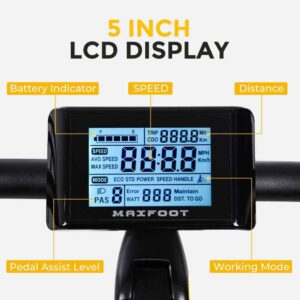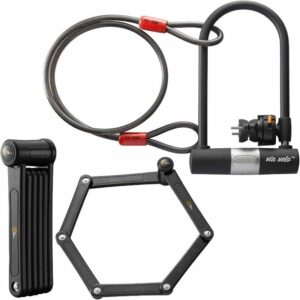Understanding How Electric Bikes Work: A Beginner's Guide
Key Takeaways
Electric bicycles utilize an electric motor to assist while pedaling, making riding easier and more enjoyable.
The motor is powered by a battery, which can be charged like any other electronic device.
Electric bicycles offer different modes of operation, including pedal assist and throttle.
Different classes of electric bikes exist to define their speed limits, power output, and usage regulations.
Electric bikes have certain advantages over manual bikes, such as easier long-distance rides and accessibility for various fitness levels, but they also come with higher costs and specific maintenance considerations.
Embark on an Electric Adventure: The Future of Cycling Begins!
As society strides towards more sustainable modes of transportation, electric bikes, often referred to as e-bikes, have been gaining considerable traction. These innovative machines seamlessly blend the physical activity of traditional cycling with the comfort and convenience of motorized propulsion, making them an increasingly popular choice for many.
If you’re new to the concept of e-bikes, this comprehensive guide is designed to navigate you through their unique mechanics and operations. By understanding how electric bikes work, you can take full advantage of their benefits and enjoy a smoother, more efficient ride.

What are Electric Bikes?
Electric bikes, often referred to as e-bikes, are an innovative modification of traditional bicycles, offering an edge in terms of convenience and effort reduction. Just like conventional bikes, they’re designed with two wheels, a seat, handlebars, and pedals, but they also feature an integral, battery-powered system that’s designed to assist riders during their journey.
At their core, electric bikes are equipped with an electric motor that provides assistance to the rider. This assistance comes in the form of power augmentation, which can help the rider pedal with less strain, conquer steep hills, or simply enjoy a leisurely ride with less exertion. The level of assistance provided by the electric motor can usually be adjusted, allowing riders to select the right amount of power boost based on their needs or the terrain.
 E-bikes are powered by a rechargeable battery that can be refilled using conventional electric outlets. The longevity and performance of these batteries can vary depending on the model, type, and usage, but generally, they can provide power assistance for several miles before needing a recharge.
E-bikes are powered by a rechargeable battery that can be refilled using conventional electric outlets. The longevity and performance of these batteries can vary depending on the model, type, and usage, but generally, they can provide power assistance for several miles before needing a recharge.
Different from regular bikes, e-bikes offer a unique blend of manual cycling and electric propulsion, allowing users to switch between traditional pedaling and electric assistance as needed. This hybrid approach to transportation offers a balance between physical exercise and mechanized convenience, making e-bikes an appealing choice for a wide range of individuals, from daily commuters to fitness enthusiasts, and even those with physical limitations.
Thus, electric bikes, while bearing many similarities to their conventional counterparts, offer a more efficient and less strenuous cycling experience, promoting ease of movement, accessibility, and environmentally friendly transportation.
How Do Electric Bikes Work?
Electric bikes amalgamate traditional cycling and electric propulsion, significantly reducing physical exertion while improving ride efficiency. The principle is straightforward: an electric motor supplements the rider’s pedaling efforts. When you pedal, sensors detect the pedaling action and signal the motor to provide a corresponding level of assistance. This motor assistance propels the bike, making the ride less strenuous for the cyclist.
Key Components of Electric Bikes:
To comprehend the functioning of electric bikes better, let’s delve into its key components:
-
Motor: As the powerhouse of an electric bike, the motor is responsible for providing the necessary power assistance. Motors can be located in different places on an e-bike: in the hub of either the front or the rear wheel (hub motor) or mounted centrally near the pedals (mid-drive motor). Each location has its advantages. Hub motors generally operate more quietly and less noticeably, while mid-drive motors are renowned for delivering a more balanced and efficient power transfer due to their central location.

-
Battery: The battery serves as the energy source for the motor. Typically, lithium-ion batteries are the go-to option for modern e-bikes due to their high energy density and longevity. This rechargeable unit can be powered up via a standard electrical outlet. The capacity of the battery is a key determinant of the electric bicycle’s range, i.e., the distance it can travel on a single charge. Larger, high-capacity batteries offer extended ranges but add to the bike’s overall weight.
-
Controller: This component acts as the mediator, regulating the flow of power from the battery to the motor. It ensures a smooth transition of power, preventing any abrupt jolts or jerks, thereby offering a smooth ride.
-
Sensors: Sensors on e-bikes are paramount in determining the degree of assistance the motor should provide. They detect variables such as pedaling force and speed and then adjust motor assistance accordingly. Two main types of sensors are typically used: torque sensors and speed sensors. Torque sensors assist proportional to the force exerted on the pedals, offering a
 more intuitive and responsive ride. Speed sensors detect the speed at which the bike is being pedaled and provide a consistent level of assistance, irrespective of the pedaling force.
more intuitive and responsive ride. Speed sensors detect the speed at which the bike is being pedaled and provide a consistent level of assistance, irrespective of the pedaling force. -
Display/Control Unit: Typically mounted on the handlebar for easy access, the display or control unit provides essential information such as the current speed, battery level, distance traveled, and the selected level of motor assistance. It allows riders to control and customize their riding experience by selecting various assistance levels or modes.
By understanding the function of these components, you can appreciate how they come together to create the enhanced cycling experience that electric bikes provide. Whether it’s tackling steep inclines or long-distance commutes, the seamless blend of human and electric power makes e-bikes a compelling choice for many riders.
Battery and Power System:
Undeniably, the battery plays a pivotal role in the functionality of electric bikes, essentially determining their range, performance, and overall usability. It stores the electrical energy needed to power the motor and, by extension, to provide pedaling assistance.
Electric bicycle batteries are commonly rated in terms of their capacity, which is measured in watt-hours (Wh). A battery’s capacity signifies the amount of electric charge it can deliver at a given voltage, which translates to the potential distance an e-bike can cover on a single charge.
Essentially, a higher-capacity battery typically equates to a longer riding range, assuming similar conditions and power usage. For instance, a 500Wh battery could provide power for an e-bike to travel between 20 to 70 miles depending on various factors like rider weight, terrain, weather, and level of motor assistance.
Modern e-bikes predominantly employ lithium-ion batteries due to their lightweight, compact nature, and superior energy density. These batteries also boast a good lifespan, often capable of sustaining several hundred charge cycles before their capacity begins to significantly diminish.
Charging electric bike batteries is a fairly straightforward task, akin to charging your mobile device. Most batteries can be charged directly on the bike, or they can be removed and charged separately for convenience. The charging process involves plugging the bike’s charging unit into a standard electrical outlet and connecting it to the battery. The charging time, however, varies based on the battery’s capacity and the power output of the charger. A typical full charge can take anywhere from 3 to 6 hours.
In addition to powering the motor, the battery system also provides energy for other electrical components on the bike, such as lights or the display unit, adding to the versatility and convenience of electric bikes.
Always remember that while higher-capacity batteries offer extended ranges, they are typically more expensive, heavier, and may take longer to charge. Thus, choosing the right battery involves balancing your range needs, budget, and convenience factors.
Pedal Assist and Throttle Operation:
Electric bikes typically feature two primary modes of operation which dictate how the electric motor assists the rider: pedal assist and throttle mode.
Pedal Assist:
- Also known as Pedelec systems or pedal-activated systems, pedal assist is the most common mode on electric bikes. As the name suggests, this system senses your pedaling motion (through cadence sensors or torque sensors) and automatically adds a certain degree of electric power assistance while you’re pedaling. This assistance
 effectively amplifies your pedaling power, helping to reduce fatigue and enabling a more comfortable riding experience, particularly on hilly terrains or during long rides.
effectively amplifies your pedaling power, helping to reduce fatigue and enabling a more comfortable riding experience, particularly on hilly terrains or during long rides. -
Pedal-assist systems usually come with multiple levels of assistance, allowing you to choose the desired level based on your current terrain, personal preference, or the need to conserve battery life. For example, a low level of assistance might suffice on flat roads, but you could crank it up when facing a steep climb.
Throttle:
- Throttle-operated e-bikes work independently of your pedaling. With a simple twist of a throttle (usually located on the handlebars, similar to a motorcycle throttle) or a push of a thumb button, the bike receives a boost from the motor, propelling it forward without any pedaling effort from the rider. This mode can be particularly useful for starting from a stop, navigating up steep hills, or when you simply want a break from pedaling.
-
However, because they can operate without any rider pedaling, throttle-assisted e-bikes may have legal restrictions in some areas, where they’re considered akin to mopeds or other motorized vehicles. Furthermore, consistent use of the throttle mode tends to drain the battery faster than pedal assist.
Both these modes of operation aim to make your ride smoother, easier, and more enjoyable. While pedal assist aligns more with the traditional cycling experience, throttle mode offers a more laid-back ride. Many electric bikes feature both modes, offering the flexibility to switch between them as per the rider’s needs. It’s worth noting that the use of these modes should comply with local electric bicycle regulations and guidelines.
Different Classes of Electric Bikes
In an attempt to standardize and regulate the use of electric bikes, many regions and countries have classified e-bikes into different categories based on their maximum power output, top-assisted speed, and method of activation. Understanding these classifications is crucial for riders, as they dictate where these bikes can be ridden and if any additional requirements such as licenses or insurance are needed. The three most common classes of e-bikes are:
Class 1 – Pedal Assist / Pedelec:
-
Class 1 electric bikes are equipped solely with a pedal-assist system, providing motor assistance only when the rider is pedaling. The motor assistance cuts off once the e-bike reaches a top speed of 20 mph (32 km/h). Given their low speed and reliance on pedaling, Class 1 e-bikes are generally allowed on any path where traditional bicycles are permitted. This includes most bike paths, trails, and bike lanes.
-
However, rules can vary by location, so riders are advised to check their local regulations or consult with relevant
 government transportation websites for specific details on where they can ride Class 1 e-bikes.
government transportation websites for specific details on where they can ride Class 1 e-bikes.
Class 2 – Throttle-On-Demand:
-
Class 2 e-bikes feature both pedal-assist and throttle modes, meaning that they can provide motor assistance even when the rider is not pedaling. Like Class 1, the motor assistance on Class 2 e-bikes ceases once they reach 20 mph (32 km/h).
-
Due to the throttle feature, Class 2 e-bikes may face stricter regulations and could be prohibited from certain bike paths or trails where Class 1 bikes are allowed. Regulations vary significantly by location, so riders should refer to local biking advocacy groups or transportation departments for more information about where Class 2 e-bikes are permitted.
Class 3 – Speed Pedelec:
Class 3 e-bikes, also known as speed pedelecs, are equipped with a pedal-assist system that can provide motor assistance up to a higher speed limit of 28 mph (45 km/h). This makes them an attractive option for fast commuting.
-
However, due to their higher speeds, Class 3 e-bikes are typically not allowed on standard bike paths or trails where lower-speed bicycles are ridden. Instead, they are usually permitted on roads and bike lanes alongside other motor vehicles. In some regions, Class 3 e-bike riders might also be required to wear a helmet, be above a certain age, and even register their e-bike. Again, riders should check with local regulations and traffic laws for specific usage guidelines, and consult government transportation websites or local bike advocacy organizations for more detailed information on where Class 3 e-bikes can be ridden.
Remember that these classes are not universally adopted, and different countries or states may have different classifications and regulations. Therefore, always check the local rules before purchasing or riding an e-bike.
Comparison: Electric Bikes vs. Manual Bikes
Electric bikes and traditional manual bikes share the same fundamental design, however, the addition of an electric motor, battery, and electronic controls on e-bikes make for a distinct riding experience and other considerations. Here are some key distinctions:
-
Assisted Riding: The standout feature of electric bikes is their motor-assisted pedaling. E-bikes can make cycling less strenuous and more enjoyable, particularly over long distances or steep inclines. This opens up cycling to a broader range of people, including those who may have been deterred by physical exertion, fitness levels, age, or health conditions. Manual bikes, on the other hand, require full physical effort from the rider at all times.
-
Cost: Given the additional components and technology, electric bikes are generally more expensive upfront than their manual counterparts. The cost of replacement batteries should also be taken into account as part of the total ownership cost.
-
Maintenance: While both types of bikes require regular maintenance like tire pressure checks and brake adjustments, e-bikes have additional electric components—such as the motor, battery, and electronic controls—that need care and may require specialized servicing.

-
Weight and Transport: Electric bikes tend to be heavier than manual bikes due to the added weight of the motor and battery. This could be a consideration if you plan to transport the bike frequently, or if you have to carry it up stairs or steep inclines without motor assistance.
-
Regulations and Restrictions: Different rules and regulations may apply to electric bikes compared to manual bikes, including speed limits, age restrictions, and requirements for registration, licensing, or insurance. Local regulations can vary widely, so it’s important to understand the laws in your area.
-
Environmental Impact: Both types of bikes offer a more sustainable mode of transportation compared to motor vehicles. However, the production, use, and disposal of batteries for electric bikes can have a larger environmental impact than manual bikes.
In conclusion, both electric and manual bikes have their own unique benefits and potential drawbacks. Your choice between the two would depend on your specific needs, preferences, and local regulations.
Safety Features and Controls
Safety and control are paramount when it comes to riding electric bikes, and manufacturers have incorporated various features to ensure both.
-
Integrated Lights: For visibility in low-light conditions, most electric bikes come equipped with integrated lights. The front light ensures you can see the path ahead clearly, while the rear light makes sure you are visible to others from behind.
-
Reflectors: In addition to lights, electric bikes often feature reflectors on the wheels, pedals, and rear of the bike to enhance visibility in various light conditions.
-
Braking Systems: Electric bikes typically feature robust braking systems such as disc brakes or hydraulic brakes, capable of handling the additional weight and speed of e-bikes. Some e-bikes also offer regenerative braking, which recharges the battery when the brakes are applied.
-
Power Modes and Assistance Levels: Electric bikes often come with a range of power modes and assistance levels, allowing riders to customize the amount of assistance
 they receive from the motor. These settings can usually be adjusted via a control panel or display on the handlebars, and can help to manage battery usage, control speed, or adjust the level of physical exertion required.
they receive from the motor. These settings can usually be adjusted via a control panel or display on the handlebars, and can help to manage battery usage, control speed, or adjust the level of physical exertion required. -
Horn or Bell: Most electric bikes are fitted with a horn or a bell as a standard safety feature. This helps the rider signal their presence to pedestrians or other road users.
-
Control Display: E-bikes typically have a display on the handlebars that provides important information such as battery level, speed, distance traveled, and power mode. Some advanced displays also offer features like GPS navigation or connectivity with smartphones for additional functionality.
It’s important to note that while these features enhance safety, they do not replace the need for safe riding habits. Riders should always wear a helmet, follow local traffic laws, and maintain awareness of their surroundings.
FAQs and Storing Electric Bikes over Winter
-
Q: How long does it take to charge an electric bike? A: Charging time varies between 3 to 6 hours, depending on the battery capacity and charger.
-
Q: Can I ride an electric bike in the rain? A: Yes, electric bikes are designed to withstand rain, but it’s essential to check the manufacturer’s guidelines for your specific model.
-
Q: Do I need a license to ride an electric bike? A: Licensing requirements vary by location. It’s best to consult local regulations, but generally, electric bikes that meet certain specifications don’t require a license.
-
Q: Can electric bikes be used without the motor assist? A: Yes, electric bikes can be pedaled just like traditional bikes without using the motor assist, offering flexibility for riders.
-
Q: Are electric bikes environmentally friendly? A: Electric bikes are more environmentally friendly than cars and motorcycles, emitting no direct pollutants and requiring less energy to operate.
-
Q: What maintenance does an electric bike require? A: Regular maintenance includes battery care, tire checks, and brake inspections to ensure optimal performance and safety.
Elevate Your Ride: Embracing the Electric Bike Revolution
Armed with a comprehensive understanding of how electric bikes function, including the distinctions between different classes and their comparison to traditional bikes, you’re now well-equipped to embark on your e-biking adventure.
Always adhere to local rules and regulations related to e-bike usage, and ensure your ride aligns with the permitted areas. The world of e-biking offers a unique blend of convenience, fitness, and eco-friendly transportation. So gear up, embrace the ride, and enjoy the manifold benefits of this innovative mode of travel.







